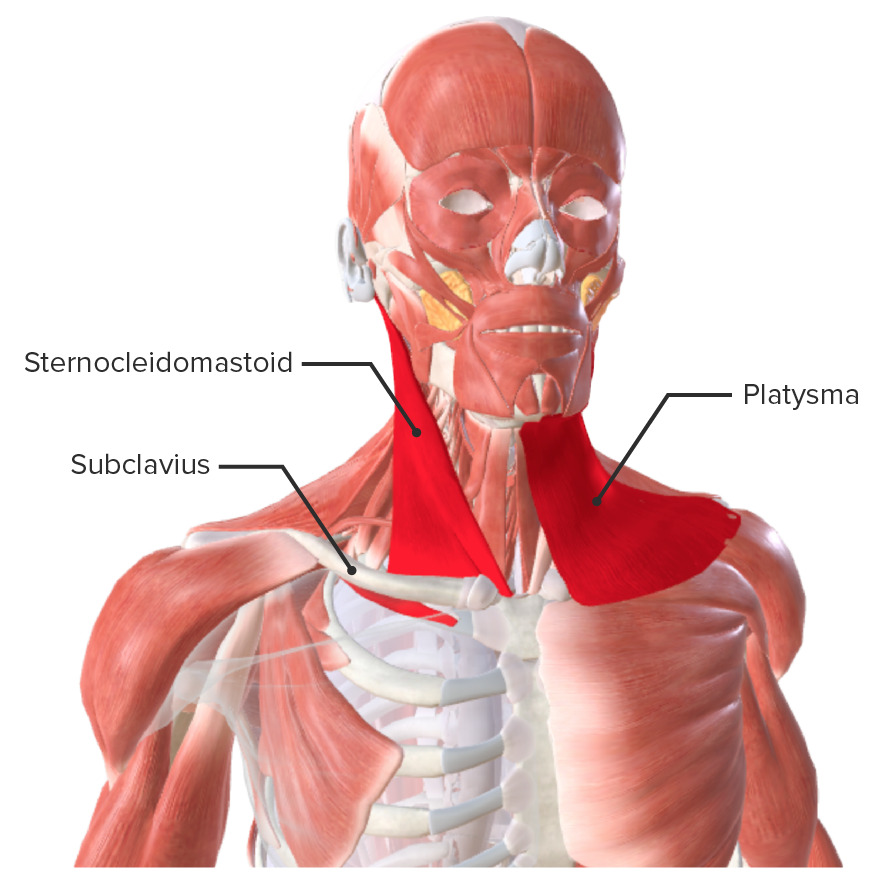Playlist
Show Playlist
Hide Playlist
Vertebral Compartment
-
Slides Anatomy Vertebral Compartment.pdf
-
Reference List Anatomy.pdf
-
Download Lecture Overview
00:01 Now let's take a look at the components of the vertebral compartment. 00:07 Here in this cross section, we see the prevertebral fascia enclosing the paravertebral muscles. 00:14 If we look at the anterior most aspect, we see there is an additional bit of fascia called the alar fascia. 00:22 And although that creates a very small space between the alar fascia and the prevertebral fascia, that space is something called the danger space because it allows the potential for spread of an infection from the cervical area all the way down into the thoracic area. 00:40 Here we see some of the muscles of the vertebral compartment. 00:44 We have the anterior vertebral muscles and the lateral vertebral muscles which collectively we'll call the prevertebral muscle group. 00:51 Then we'll look at the posterior vertebral muscles separately. 00:56 Here we have the anterior vertebral muscles. 01:01 We have the rectus capitis lateralis, rectus capitis interior, and the longus capitis. 01:08 And the word capitis in these muscles tells us that they're attaching to the head. 01:14 We also have the longus colli which doesn't have capitis in its name. 01:18 So these are just attaching cervical vertebrae to each other. 01:22 And together they're going to cause flexion. 01:26 If we swing around to a lateral view, we see the lateral vertebral muscles, which are the scalene muscles - the anterior, middle, and posterior scalene. 01:36 Here we see they're attaching to the transverse processes of the cervical vertebrae out to the ribs. 01:42 So for the anterior and middle scalenes are attaching to the anterior surface of the first rib. 01:49 And then for the posterior scalene is touching to the upper surface of the second rib. 01:55 And together they act to elevate the first and second ribs respectively. 02:01 If we swing around posteriorly, we'll see the posterior vertebral group. 02:05 And here we're looking at the suboccipital muscles which have the obliquus capitis superior, obliquus capitis inferior rectus capitis posterior major and minor. 02:19 And together they're going to cause extension of the head because they all have capitis in their name. 02:25 We also see another triangle of the neck a very small one called the suboccipital triangle that's bordered by the rectus capitis posterior major, the obliquus capitis inferior and the obliquus capitis superior. 02:40 And there's not a whole lot that we can find through here but we do see the vertebral artery. 02:45 In fact at one point, this was an important access point for certain types of angiography of the brain.
About the Lecture
The lecture Vertebral Compartment by Darren Salmi, MD, MS is from the course Neck Anatomy.
Included Quiz Questions
What is a concern regarding the "danger" space?
- Potential spread of infection from the cervical area to the thoracic region
- Potential spread of infection from the abdominal area to the thoracic region
- Potential spread of infection from the abdominal area to the pelvic region
- Potential spread of a CSF leak
- Potential spread of a hemorrhage
What is the origin of the scalene muscles?
- Transverse processes of cervical vertebrae
- Transverse processes of thoracic vertebrae
- Upper surface of the first rib
- Lower surface of the first rib
Customer reviews
5,0 of 5 stars
| 5 Stars |
|
5 |
| 4 Stars |
|
0 |
| 3 Stars |
|
0 |
| 2 Stars |
|
0 |
| 1 Star |
|
0 |




